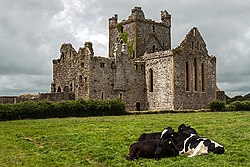Campile
| Campile Irish: Ceann Poill | |
| County Wexford | |
|---|---|
 Dunbrody Abbey, west of Campile | |
| Location | |
| Grid reference: | S726155 |
| Location: | 52°16’60"N, 6°55’60"W |
| Data | |
| Population: | 448 (2016) |
| Local Government | |
Campile is a small village situated in County Wexford, nine miles south of the town of New Ross. As of the 2016 census, Campile had a population of 448 people.
The name of the village is from the Irish language; from Ceann Phoill or Ceann Poill, meaning 'Head of the creek'.[1][2]
History
Archaeological evidence of ancient settlement in the area include several burnt mounds and ringforts in the neighbouring townlands of Ballyvelig, Tinnock, and Dunbrody.[3] Approximately 1 km southwest of Campile is the 12th century Dunbrody Abbey, and the 17th century bawn of the (incomplete) Dunbrody Castle.[4]
In 1798, during the United Irishmen Rebellion, a rebel camp was located on nearby Slieve Coillte hill.

During the Second World War, in which the Irish Free State remained officially neutral, the Germans bombed Campile.
The bombing took place on 26 August 1940. The bombs were dropped by a lone German bomber that appeared over Campile around lunch time.[5] The first bomb dropped failed to detonate. Local man Teddy Drought, who was fifteen years old and worked in Shelburne Co-op at the time of the bombing, described witnessing the aircraft approach and the first bomb being dropped while sat on a wall with a friend. In an interview with RTÉ in 1990, Drought recalled the following scene:
"A bomb come down-we didn't know at the time it was a bomb-came down through the roof and down on the ground alongside the two of us (...) it busted, it didn't explode".[5]
After dropping this first bomb, the plane circled and dropped an additional three bombs over the Shelburne Co-op creamery and restaurant area. Approximately 150 employees worked at the Shelburne Co-op at the time of the bombing.[5]
Three women were killed during this daylight bombing – Mary Ellen Kent (30), her sister Catherine Kent (26), both from Terrerath, and Kathleen Hurley (27) from Garryduff.[6][7][8] The bomb that exploded and killed the three women landed on the restaurant section of the Co-op where the women had been working.[5] A total of four German bombs were dropped on the creamery and restaurant sections of Shelburne Co-op, and the railway line was also targeted. Greater loss of life was narrowly avoided due to approximately fifty employees leaving the restaurant after the lunch time rush shortly before the bomb was dropped.[5]
The attack has never been fully explained. Some historians have suggested that it was a deliberate attack to discourage the supply of foodstuffs to wartime Britain.[9] However a commonly given explanation for the bombing is that the German pilot was lost, and mistook Ireland's south-east for Wales.[5]
Following the bombing, precautions were taken in an attempt to protect locals in the event of another attack. For example, sirens were installed in the village that would sound at the Shelburne Co-op any time a plane flew overhead for the duration of the war. In an interview with RTÉ reporter Michael Ryan in 1990, the area manager of Waterford Cooperative Tom Connery claimed that upon hearing these sirens locals would "lay awake at night wondering if it was them again".[5]
On the occasion of the 70th anniversary of the bombing, a memorial garden was dedicated to the memory of the three women who died.[10]
Railway

Campile railway station opened on 1 August 1906.[11] On 21 July 2010, Irish Rail announced that it would suspend its rail service through Campile, and this took effect after the operation of the evening train on 18 September 2010.[12] Before that date, it was served Mondays to Saturdays by one passenger train in each direction.
Sport
- Football: Campile United
- Gaelic sports: Horeswood GAA
Outside links
References
- ↑ Mills, Anthony David: 'A Dictionary of British Place-Names' (Oxford University Press, 2003) ISBN 978-0-19-852758-9
- ↑ Ceann Poill / Campile: Placenames Database of Ireland
- ↑ Recorded Monuments Protected Under Section 12 of the National Monuments (Amendment) Act 1994 - County Wexford. Office of Public Works. 1995. p. 39. https://www.archaeology.ie/sites/default/files/media/pdf/Archaeology-RMP-Wexford-Manual-(1995)-0054.pdf.
- ↑ "Left Unfinished - Dunbrody Castle". 13 April 2020. https://theirishaesthete.com/2020/04/13/dunbrody/. Retrieved 10 August 2020.
- ↑ 5.0 5.1 5.2 5.3 5.4 5.5 5.6 "Campile Bombing" (in en). https://www.rte.ie/archives/2020/0727/1155743-campile-bombing/.
- ↑ Furlong, Nicholas (2003). A History of County Wexford. Dublin: Gill & MacMillan. p. 143. ISBN 0-7171-3461-X.
- ↑ "Bombing of Campile remembered". Wexford People. 1 September 2000. http://www.wexfordpeople.ie/news/bombing-of-campile-remembered-992708.html. Retrieved 9 May 2008.
- ↑ "August 27th, 1940: From The Archives (reprint of article published 27 August 1940)". Irish Times. http://www.irishtimes.com/newspaper/opinion/2010/0827/1224277687539.html. Retrieved 22 March 2020.
- ↑ "The day Hitler's bombs brought death to a quiet Wexford village". Independent News & Media. 9 August 2010. https://www.independent.ie/lifestyle/the-day-hitlers-bombs-brought-death-to-a-quiet-wexford-village-26670518.html. Retrieved 10 August 2020.
- ↑ "Wexford village to commemorate Second World War bombing". Irish Examiner. 6 August 2010. https://www.irishexaminer.com/news/arid-30468245.html. Retrieved 10 August 2020.
- ↑ "Campile station" (PDF). Railscot - Irish Railways. http://www.railscot.co.uk/Ireland/Irish_railways.pdf. Retrieved 7 September 2007.
- ↑ "End of the line". Independent News & Media. 21 September 2010. https://www.independent.ie/regionals/newrossstandard/news/end-of-the-line-27500648.html. Retrieved 10 August 2020. "the last ever journey of the Waterford to Rosslare train on Saturday evening [..travelled..] via Campile, Ballycullane, Wellingtonbridge, Bridgetown and Rosslare Strand, before arriving at the last stop in Rosslare Harbour"